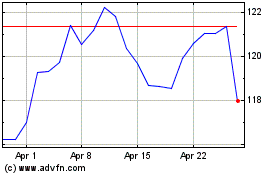ExxonMobil Sets Record in High Performance Oil and Gas Reservoir Computing
February 16 2017 - 9:00AM
Business Wire
- Proprietary software demonstrates
record performance using 716,800 computer processors
- Reservoir development scenarios can be
examined thousands of times faster
- Efficiency in reservoir modeling
reduces time in informing business decisions
ExxonMobil, working with the National Center for Supercomputing
Applications (NCSA), has achieved a major breakthrough with
proprietary software using more than four times the previous number
of processors used on complex oil and gas reservoir simulation
models to improve exploration and production results.
The breakthrough in parallel simulation used 716,800 processors,
the equivalent of harnessing the power of 22,400 computers with 32
processors per computer. ExxonMobil geoscientists and engineers can
now make better investment decisions by more efficiently predicting
reservoir performance under geological uncertainty to assess a
higher volume of alternative development plans in less time.
The record run resulted in data output thousands of times faster
than typical oil and gas industry reservoir simulation. It was the
largest number of processor counts reported by the oil and gas
industry, and one of the largest simulations reported by industry
in engineering disciplines such as aerospace and manufacturing.
“This breakthrough has unlocked new potential for ExxonMobil’s
geoscientists and engineers to make more informed and timely
decisions on the development and management of oil and gas
reservoirs,” said Tom Schuessler, president of ExxonMobil Upstream
Research Company. “As our industry looks for cost-effective and
environmentally responsible ways to find and develop oil and gas
fields, we rely on this type of technology to model the complex
processes that govern the flow of oil, water and gas in various
reservoirs.”
The major breakthrough in parallel simulation results in
dramatic reductions in the amount of time previously taken to study
oil and gas reservoirs. Reservoir simulation studies are used to
guide decisions such as well placement, the design of facilities
and development of operational strategies to minimize financial and
environmental risk. To model complex processes accurately for the
flow of oil, water, and natural gas in the reservoir, simulation
software must solve a number of complex equations. Current
reservoir management practices in the oil and gas industry are
often hampered by the slow speed of reservoir simulation.
ExxonMobil’s scientists worked closely with the NCSA to
benchmark a series of multi-million to billion cell models on
NCSA’s Blue Waters Super Computer. This new reservoir simulation
capability efficiently uses hundreds of thousands of processors
simultaneously and will have dramatic impact on reservoir
management workflows.
“NCSA’s Blue Waters sustained petascale system, which has
benefited the open science community so tremendously, is also
helping industry break through barriers in massively parallel
computing,” said Bill Gropp, NCSA’s acting director. “NCSA is
thrilled to have worked closely with ExxonMobil to achieve the kind
of sustained performance that is so critical in advancing science
and engineering.”
ExxonMobil’s collaboration with the NCSA required careful
planning and optimization of all aspects of the reservoir simulator
from input/output to improving communications across hundreds of
thousands of processors. These efforts have delivered strong
scalability on several processor counts ranging from more than
1,000 to nearly 717,000, the latter being the full capacity of
NCSA’s Cray XE6 system.
About ExxonMobil
ExxonMobil, the largest publicly traded international oil and
gas company, uses technology and innovation to help meet the
world’s growing energy needs. We hold an industry-leading inventory
of resources and are one of the largest integrated refiners,
marketers of petroleum products and chemical manufacturers. For
more information, visit www.exxonmobil.com or follow us on Twitter
www.twitter.com/exxonmobil.
Cautionary Statement: Statements of
future events or conditions in this release are forward-looking
statements. Actual future results, including the results and impact
of new technologies, could vary depending on the outcome of further
research and testing; the development and competitiveness of
alternative technologies; technical and operating factors; and
other factors discussed in this release and under the heading
“Factors Affecting Future Results” on the Investors page of
ExxonMobil’s website at exxonmobil.com.
About the National Center for Supercomputing
Applications
The National Center for Supercomputing Applications (NCSA) at
the University of Illinois at Urbana-Champaign provides
supercomputing and advanced digital resources for the nation’s
science enterprise. At NCSA, University of Illinois faculty, staff,
students, and collaborators from around the globe use advanced
digital resources to address research grand challenges for the
benefit of science and society. NCSA has been advancing one third
of the Fortune 50 for more than 30 years by bringing industry,
researchers and students together to solve grand challenges at
rapid speed and scale. The Blue Waters Project is supported by the
National Science Foundation through awards ACI-0725070 and
ACI-1238993.
View source
version on businesswire.com: http://www.businesswire.com/news/home/20170216005118/en/
ExxonMobilMedia Relations, 832-625-4000orNCSAMedia Relations,
217-343-1594
Exxon Mobil (NYSE:XOM)
Historical Stock Chart
From Mar 2024 to Apr 2024

Exxon Mobil (NYSE:XOM)
Historical Stock Chart
From Apr 2023 to Apr 2024
